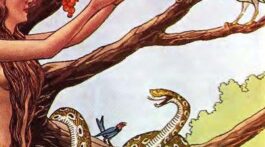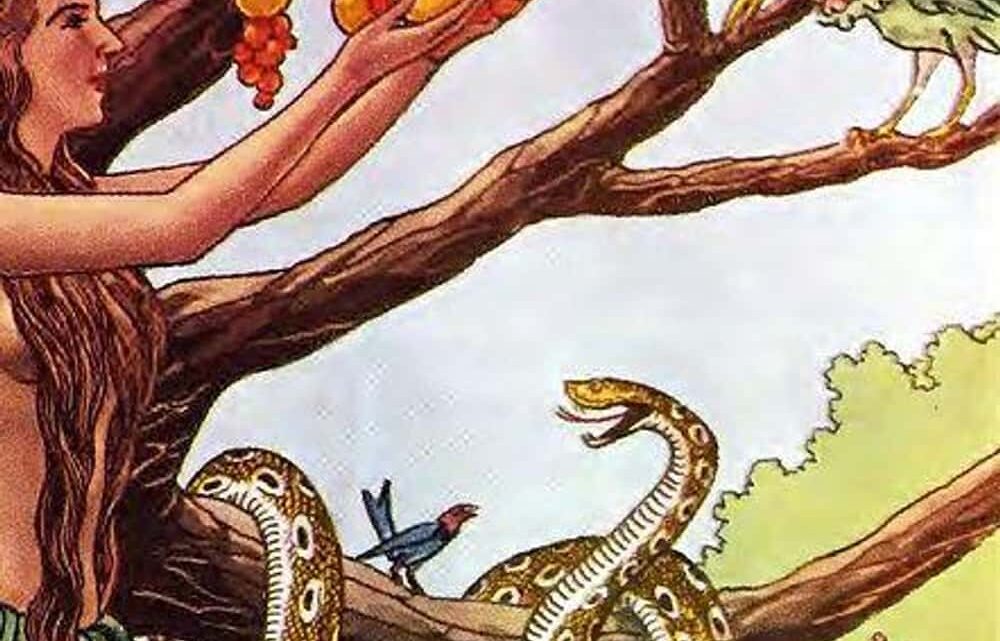If Job’s Cosmic Courtroom forms the frame for all of the Mural of Salvation, then it encompasses the whole vast picture, the whole narrative of Salvation History. Within the painting, we should find images and patterns that repeat and echo from one end to the other. In literary terms, we should find these from Genesis to Revelation. Enter the Serpent.
Chapter 3 begins this way: “Now the serpent was most cunning of all the beasts of the field that the LORD God had made,” and this serpent immediately strikes up a conversation. We don’t find this shocking because of our familiarity with the story, but if we encountered a talking snake in real life, or in a modern story, we would find it stunning. But our reaction doesn’t matter —only the reaction of original audience matters.
In the ancient Near East, creation myths commonly centered around a battle between a god and a sea serpent. The sea serpent had many names in the various stories, but always represented chaos and disorder, and thus the main powerful adversary. The instant the ancient audience sees the Serpent in the Tree, they know battle is about to be joined.
God always meets people where they are, and thus when Genesis wants to introduce an adversary in the Garden of Eden, it takes the form the audience will understand—the menacing arch-villain, the Serpent.
The Serpent shows up early in the Grand Mural of Salvation. It resurfaces throughout the Old Testament under many names—Leviathan, Behemoth, Rahab[1], among others. And lest there be any doubt about the Serpent’s identity, Revelation 12:9 —at the opposite side of the Grand Mural—clears it up once and for all: “the great dragon . . . . the serpent of old who is called the devil and Satan.”
Although we may be surprised at the appearance of the Serpent in the Garden, his behavior identifies him with Satan in the Cosmic Courtroom scenes: he quickly accuses God of lying. “You certainly will not die!” if she eats the fruit of the tree, he tells her. Even without a courtroom setting, he immediately puts God on trial! Just like in the scenes in Job, his accusations focus on God, not on humanity.
According to the Serpent, God has lied to humanity, falsely telling them that they will die if they eat from that Tree, and doing so in order to keep them ignorant, and prevent them from becoming like Him. And just as in the Cosmic Courtroom, creatures are asked to pass judgment on God, whether He has acted justly, or whether He is guilty of injustice.
This accusation will take many forms, but it will be raised repeatedly throughout the ages. Too often, human kind will be deceived and rail at God for the trials and suffering which the Serpent, in his many forms, will bring upon them but attribute to their Creator.
But the Grand Mural depicts God’s saving actions on behalf of His people. So, no matter how often they fall for the lies of the Serpent, God continually provides a means of deliverance. Genesis 3 simply provides the first example. Though their sin has rendered them naked, and their own efforts failed to remedy this, God clothes them. And as the rest of the consequences of their sin become evident—being cast out of the Garden, the soil rebelling by producing thorns and thistles, marriage and childbirth becoming sources of conflict and pain—God promises deliverance. The Serpent cannot claim total victory: though he has deceived humankind into abandoning their allegiance to God, it has not been transferred to him. Instead, their will be enmity towards him, and though he has wounded humankind, he will ultimately be destroyed: God will deliver those who will let Him.
As we go forward, we will look for this pattern to be repeated throughout the Grand Mural. . . and we will not be disappointed!
[1] Although the English transliteration of the name is the same, the Hebrew name of the Serpent is different from the woman in Joshua 2.










